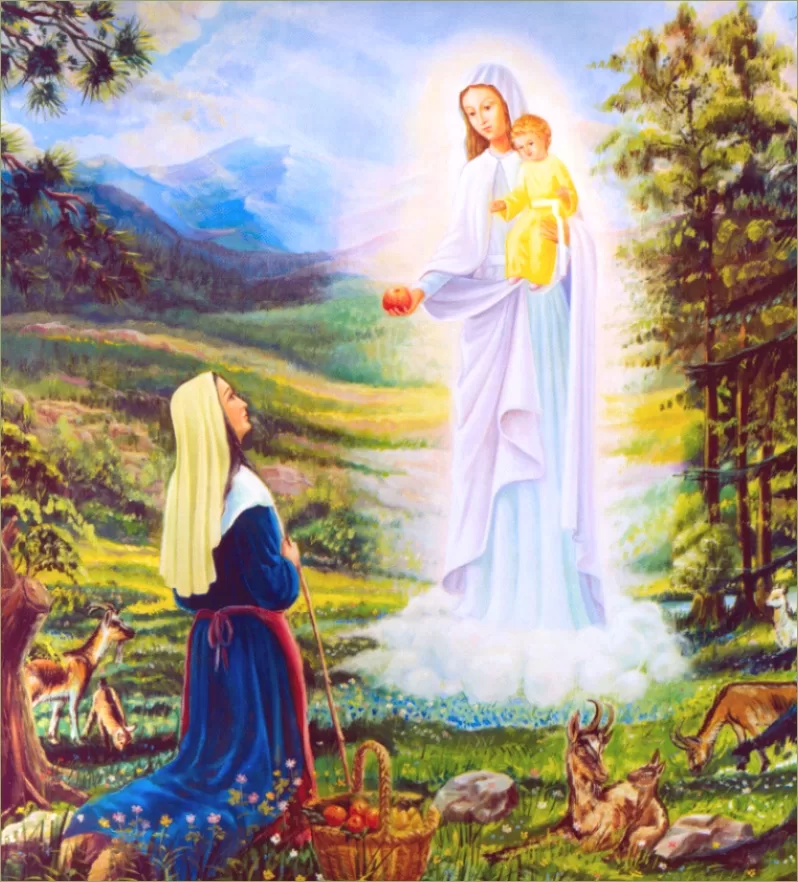
Category: Mary
-

Explanation of Mother of Unity and Hope Image
Read More: Explanation of Mother of Unity and Hope ImageBy Yves Jacques Bishop Roman Danylak, former bishop of the Ukrainian Catholic Diocese of Toronto, Canada, approved this image. A priest from the Vatican called the image a “complete theology”, and had it blessed by Pope Benedict XVI. Summoning her children with an intensity found throughout the messages given to a privileged soul, Our Mother…
-

Powerful Prayer| Our Lady of Laus| Refuge of Sinners
Read More: Powerful Prayer| Our Lady of Laus| Refuge of SinnersPrayer to Our Lady of Laus Queen of Laus, kind and loving Mother, hear our pious pleas. Your son always hears your prayers, and you always hear your children. O pure Virgin, ceaselessly watch over our hearts from heaven. Let no dirt tarnish the heavenly whiteness. Be our support in virtue, all-powerful Virgin, and guide…
-

Why You Should Pray (Rosary) in Latin?
Read More: Why You Should Pray (Rosary) in Latin?Latin is a Sacred Language The Latin language was consecrated at the Passion by its mystic inscription on the Cross. “From the first four centuries, no liturgy can be shown to be composed in any other language other than the three languages from the inscription on the Cross.” (Gihr) The Body of Christ was nailed to the Cross,…
-

Prayer to Our Lady of China, the Great Mother (Nostra Domina de Sina)
Read More: Prayer to Our Lady of China, the Great Mother (Nostra Domina de Sina)Prayer Hail, Holy Mary, Mother of Our Lord Jesus Christ, Mother of all nations and all people. You are the special heavenly Mother of the Chinese people. Teach us your way of total obedience to God’s will. Help us to live our lives true to our faith. Fill our hearts with burning love for God…
Search
Popular Posts
-
🙏 A New Chapter Begins: Supporting Pope Leo XIV with Prayer and Hope | W/ Daniel O’Connor
“Give the new pope a break and support him with your prayers.”–…
-
Possible Candidates for The Next Pope!
Some Candidates for the New Papacy Today we will share with you…
Categories
Archives
Tags
#Miracles (102) 2023 (4) 2024 (4) approved miracles (2) catholic (141) catholic blog (375) catholic meditations (7) catholic miracles (371) catholic motivation (2) catholic news (371) catholic prayers (4) CatholicSeers (359) catholic vlog (375) catholic websites (6) Eucharistic miracle (2) fr jim blount (3) GisellaCardia (11) hamas (3) imitation of christ (2) Israel (4) israel live (5) Israel news (9) jesus (3) jesus christ (4) Latest messages (11) lent 2023 (10) lent 2024 (4) lent homily (2) lent retreat (4) lent retreat 2023 (3) Lourdes (2) messages from god (6) MessagesFromHeaven (364) miracles of catholic church (2) mother and refuge (2) ourlady (325) OurLadyApparitions (22) our lady of lourdes (2) Pope (2) POPE francis (3) pope francis news (2) prayers (3) real miracles (356) sacred heart of jesus (2) The Miracles of Lourdes (2)







